Andrew Macarthy's Blog, page 16
July 14, 2016
6 Ways to Use Pokemon Go to Promote Your Business And Drive Sales (With the Help of Social Media)

6 Ways to Use Pokemon Go to Promote Your Business And Drive Sales (With the Help of Social Media)
Heard about the new Pokémon Go craze? Want to harness the power of Pokémon Go and social media to drive traffic and sales to your business? In this blog post, I'll show you how.
What is Pokémon Go?Pokémon Go is a mobile game from Nintendo/Niantic based on the hugely popular monster-collecting franchise, available for free for Android and iOS devices. In it, players use GPS to explore the real world and catch Pokémon through augmented reality encounters.
It shot to the top of the App Store on the day of its release, and within 24 hours Pokémon GO surpassed Supercell’s Clash Royale to become the most downloaded mobile game of 2016. Less than a week after launch in July 2016, Pokémon Go had gained over 65 million users in the US - more than Twitter as a whole.
1. Advertise yourself as a "PokéStop"We're a #pokestop! Get $3 off/lb from the hot/salad bar when you show your #pokemon trainer profile at check out. pic.twitter.com/Fz1DLEMpEb
— Whole Foods B'ham (@wholefoodsbham) July 14, 2016
PokéStops are predetermined landmarks in public places (churches, gyms, shops, cafes, etc.), that reward players for visiting with Pokéballs (small, spherical contraptions used to capture and house Pokémon), and experience points that help them to level up their character (make it stronger).
Use the app to see if your business has been marked on the map as a PokéStop - it's pure luck at the time of writing, you may be or you may not. If it has (or there is one nearby - not at a rival store, obviously - then get on social media and let people know! While they're at it, busy hunting Pokémon, be sure to tempt them in with special offers. In the above example, Whole Foods offers a discount at the salad or hot food bar for customers who present their Pokémon trainer profile.
2. Use Lure Modules to attract more customersWe've got unusual guests this week, thanks to #PokemonGo. Enjoy your visit, wildly popular virtual creatures! pic.twitter.com/hqpqSX5XrF
— National WWII Museum (@WWIImuseum) July 12, 2016
In Pokémon Go, Pokémon are generally found by chance as a player walks around wherever they happen to be. When they spot one in the distance, they can approach it and try to capture it. However, the Lure Module is a paid-for power-up that attracts Pokémon to a PokéStop for 30 minutes. So if your place of business is already a Pokéstop, you can make it even more attractive to players (and potential customers) by having Pokémon themselves appear there.
Some players might forego the chance to visit a PokéStop such is their abundance, but if there's a location where a Pokémon they need to capture is hiding, they're much more likely to want to visit.
At L’inizio’s Pizza Bar in Queens, food and drink sales spiked by about 30% compared with a typical weekend, according to pizzeria manager Sean Benedetti. Already marked as a PokéStop, Benedetti spent about $10 on Lure Modules, and players soon swarmed to the location. “People are coming out of the woodwork because of this game,” he said.
Seattle trainers! We'll be dropping lures & giving out goodies @ Occidental Square from 12pm-1pm tomorrow (Thurs)! pic.twitter.com/VCVusOkWKK
— Sanshee (@TeamSanshee) July 14, 2016
As lures will incur a cost (1 Lure Module = 100 Pokécoins ($0.99), 8 Lure Modules - 680 Pokécoins ($6.86)), make sure you designate it as part of your marketing budget. To make the most of the opportunity, make clear to people on social media where you are, and what times you will be dropping lures. This should help maximise traffic to your location, especially if general footfall isn't high - people may make sure that they are nearby at the time of a lure drop, rather than randomly passing by. Once your lures are down at the Pokémon have started to appear, screen grab images of them to post on social media (proof!), along with the name of the Pokémon, and the hashtag #PokemonGo.
3. "Host" Gym Battle TournamentsNot a Pokémon Go player yet? Stick with me on this one...
Pokémon Gyms are hubs at which trainers gather to battle their Pokémon against one another. Like PokéStops, they are represented in the real world by places of interest, often where lots of people might gather. Pokémon Go players choose to join one of three teams near the start of their in-game journey, and as part of these teams, can combine forces to fight for control of local Pokémon Gyms. Gyms are protected by a leader (the trainer who has the strongest Pokémon) and multiple other trainers that must be defeated and kicked out before the leader. Each of these players leaves their strongest Pokémon at the gym to protect it, but must physically return to it to check that it isn't in danger of being taken over.
If I owned a business that was a Pokemon Gym I'd def have a "whatever team holds this gym gets a discount" deal, I'd get all the business
— Flint Flossy (@JariDoubleU) July 14, 2016
If your business is a designated gym or there is one nearby, advertise on social media that you'll be hosting a gym tournament in advance, perhaps even offering discounts to gym battle winners. Then, on game day, players who successfully become gym leaders or retain their spots (with proof of gamer ID) will be entitled to a discount.
4. Encourage customers to tag you with Pokémon GoIf you find Pokemon or his friends at one of our dining locations - tweet us! You could win a $25 gift card
June 14, 2016
5 Examples of Boring Businesses That Prove ANY Brand Can Win on Social Media
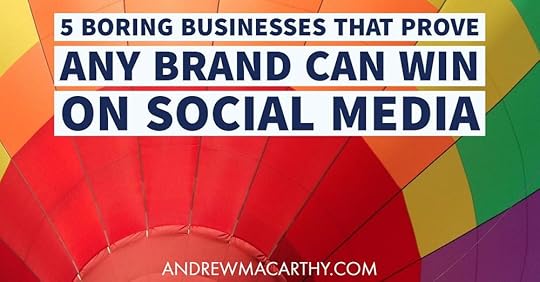
5 Examples of Boring Businesses That Prove ANY Brand Can Win on Social Media
Do you run what might be considered a "boring" business? Think you can't make a meaningful impact on social media? Think again!
Just because you're not a sexy fashion company or trendy coffee shop doesn't mean that you can't draw inspiration from other "more fashionable" businesses and apply their ideas to your own content marketing, or conjure up some more unique ways to draw attention to your brand.
In this blog post, I'll show you 5 examples of brands who have innovated in the "boring" business space on social media, and hopefully inspire you to do the same.
1. Ronseal - Slow marketingRonseal specialises in paint, varnishes, and other products that help protect people's garden fences, decking, furniture, and stuff like that. Aware that it's products aren't the most exciting, and jumping on the craze for "slow television", it produced a video that showed - in real time - a man painting a fence with one of its paint products.
The video originally aired on television - taking up a whole ad break - but has also been shared to social media. The jarring nature of the promotion caught people's attention, and provided Ronseal with a great deal of exposure.
“It’s got nothing you would associate with a normal TV advert and that in itself is intriguing,” the creative agency behind the ad, said. “It’s about stealing viewers’ attention back at a time when their are hundreds of channels and so many different screens to look at. There’s not much happening – it’s a man painting a fence, drinking from a cup of tea with a dog barking in the background – but it sucks you in.”
Slow promotions won't work for every brand -not least because, if everyone does it, the novelty would quickly wear off, making the campaign less impactful. But if the mood would suit your brand message, then it's well worth considering.
2. Charmin - humourYou wouldn't think there's a lot of mileage in bathroom matters, but Charmin continues to innovate when it comes to market its product - toilet paper - on social media. It concentrates on making light of what is often a subject that people don't like to talk about, in a fun and conversational way. In the example above, Charmin teases that its paper is so soft, it can replace the pillow you sleep on.
Summarising its approach to content marketing on social media, Charmin's social media team told Social Media Today:
“At the end of the day, it boils down to authenticity. Define what your brand stands for and your voice. Don’t try to be something you’re not. It may be humor and entertainment, or it could be informative or educational. Understand the nuances of the different platforms and your community and how your brand is represented in each.”
3. PG Tips - newsjackingPG Tips is a British tea brand, whose mascot, Monkey, has fronted the company since 2006. Tea-drinking being so linked to British culture, the brand is perfectly placed to associate itself with events of national importance. 2016 marks the Queen's 90th birthday, so PG Tips used the opportunity to start a sing-a-long of Happy Birthday on social media. And, of course, a mascot is a much more emotive representation of the brand than a tea bag! It's a good example of the way that your brand can attach itself to something bigger than itself, a culturally significant event or other, to garner some extra attention.
4. Geico - providing valueAsk anyone to suggest a boring business type, and insurance will probably be close to the top of their list. GEICO knows that gong heavy on the insurance chat won't endear an audience on social media, so it instead focuses on providing education and value in links to its blog post - like in the example above, providing practical advice for fans in an area related to its service.

GEICO does mix in promotion of its products within social posts, but mostly leaves the "hard sell" to a small mention at the end of its blog posts (pictured above). The idea being that readers will be more interested and inclined to click after receiving lots of helpful information, from a company that clearly demonstrates that it knows what it is talking about.5.
5. Transferwise - relatableSome of the most affecting posts on social media are ones that make the viewer say, "Aha, that's me, too...". Transferwise is a business that helps people wire money worldwide without the fees of some big banks, and it knows that touting the benefits of their service won't work for every post. Joe Cross, Head of Consumer Marketing at TransferWise was quoted by Seedcamp as saying that "too often, startups talk about rational benefits of their products, whereas emotional hooks are much more powerful."
As a more subtle way to promote its brand and encourage them to sign up, it produces videos like the one above - asking people from around the world what they know about other countries. It loosely relates to the service Transferwise offers and a strand of video content that has exploded in popularity in recent years, thanks to sites like Buzzfeed.
Over to youAre you a "boring" brand that has found success on social media, or have these strategies inspired you to think differently about how you will market your business on social media? Let me know in the comments below!

Andrew Macarthy is a social media consultant and the author of the #1 Amazon Web Marketing Bestseller, 500 Social Media Marketing Tips.
Buy 500 Social Media Marketing Tips
Amazon US: http://www.amazon.com/dp/B007L50HE6
Amazon UK: http://www.amazon.co.uk/dp/B007L50HE6
Follow Me:
www.facebook.com/500socialmediatips
www.twitter.com/500socialmediatips
www.instagram.com/500socialmedia
www.pinterest.com/500socialmedia
www.youtube.com/500socialmediatips
June 2, 2016
Canva vs Adobe Spark, Which is the Best for You? A Comparison of Image Creation Tools For Social Media

Canva vs Adobe Spark - Which is Better? A Comparison of Image Creation Tools For Social Media
Are you looking for an easy way to create stunning graphics for social media?
For a few years now, Canva has been the tool of choice for me and thousands of other brands - a simple, intuitive graphic creation tool. In fact, Canva announced in October 2015 that it had attracted over 5 million users worldwide.
But now, it's got competition in the form of Adobe Spark, the guys behind Photoshop, Illustrator, Final Cut, and the like.
Spark is described as a visual storytelling tool and, upon its launch, was described Bryan Lamkin, executive vice president and general manager, Digital Media at Adobe, as a way for anyone to create striking web content:
Today anyone can create content and share it via social media, but most people lack the skill, time and resources to create something that cuts through the online clutter. With Adobe Spark, anyone can create authentic, professional looking visual content for their project, passion, cause or business.
But which is better? Canva or Adobe Spark? In this blog post, I'll compare the two tools' web apps in a number of areas, and help you decide which you should be using to build your brand's graphics. Let's go!
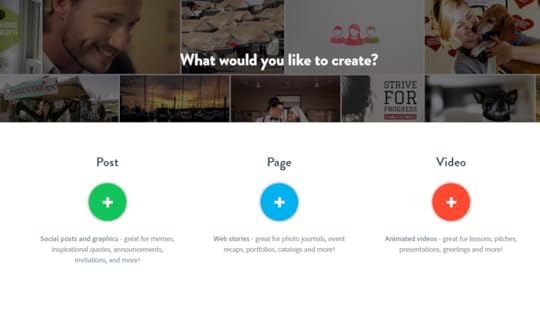
Note: This comparison will focus only on the the creation of static images (Adobe Spark lets you make videos and pages, too - features that Canva doesn't have anything to compare with at the time of writing.
Round 1: Social media image size templates
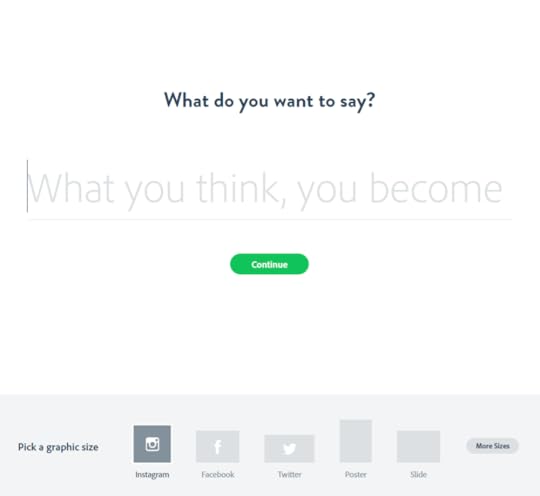
Both Canva and Adobe Spark offer an array of preset image templates, both for the most popular social networks - Facebook, Twitter, Pinterest, etc. Canva displays the dimensions of each template in pixels and gives you the option to create an image with custom dimensions if you wish. Meanwhile, Spark automatically resizes any image to fit its fixed template sizes and there is no custom dimensions option.
Winner: CanvaRound 2: Free image sourcing optionsIn Spark, you can upload your own image, grab it from Lightroom, Google Drive or Dropbox, or there's a search engine that digs up royalty-free images from Creative Commons sources - very convenient! At present, Adobe Spark and all of its options are completely free to use. Images can be downloaded clean and used however you please, and if you choose to share the image to social media from the platform, the #AdobeSpark watermark that you see while designing (below) will be removed - in return for a link back to your content.
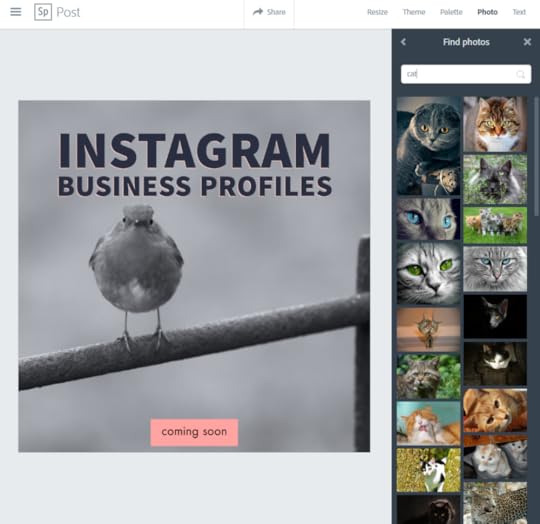
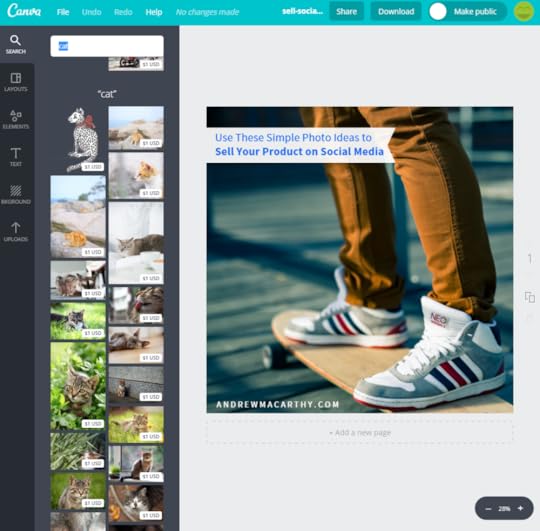
In Canva, You can upload your own images or search a database of more than 1 million. Some are free (not as many or of the quality that Spark finds, though), and the rest will cost you a flat fee of $1.00 each to use. Paid images may have license restrictions for their use, so do be careful.
Winner: SparkRound 3: Image and text editing toolsAdobe Spark's interface aims to make image creation as instant as possible. Enter some text, click through, and you'll be presented with a variety of suggested themes. Selecting these themes will instantly change the look and feel of the text and image elements of your post, as below:
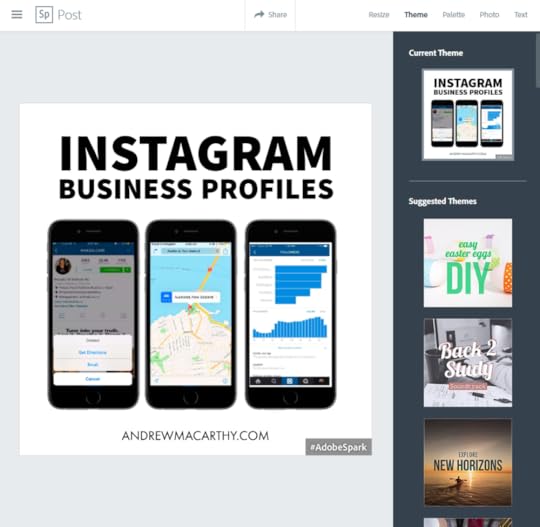
For a super quick solution or a base to work from, Spark's preset themes are okay, but nine times out of ten, you'll want to customise to match your exact branding.
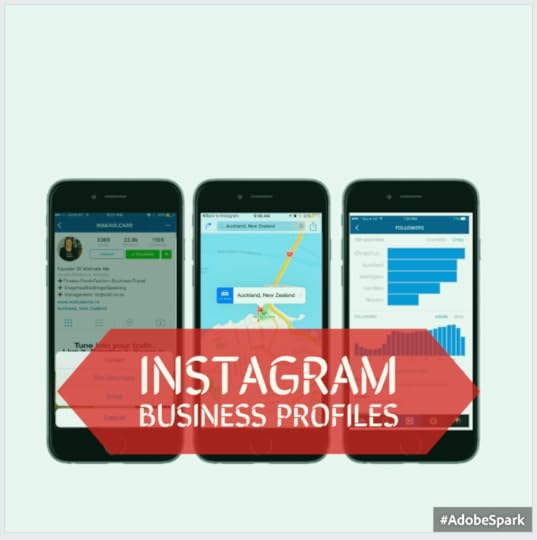
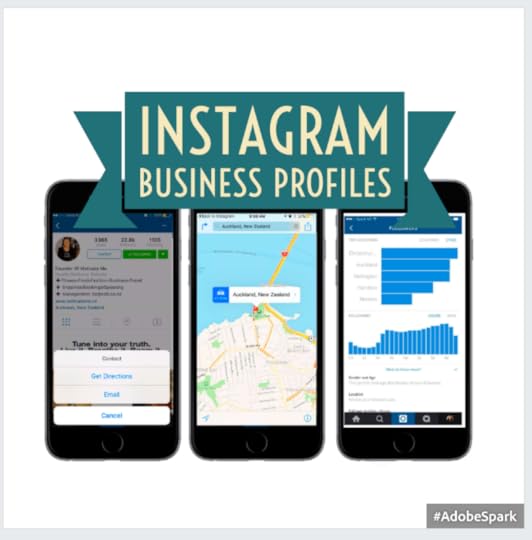
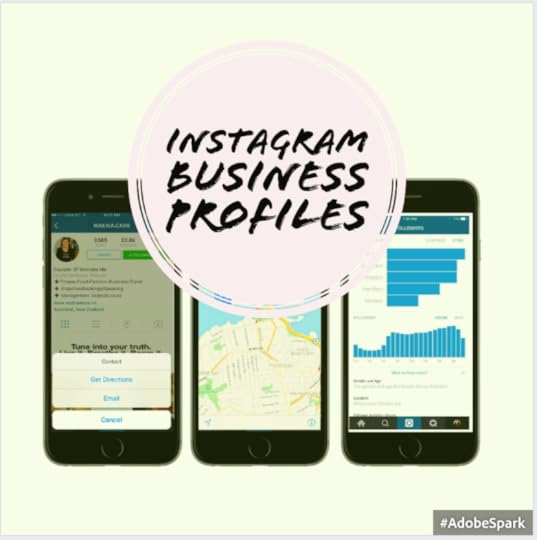
The first layer of customisation in Spark - still just suggestions, however - is with colour themes (affecting text only), photo filters (affecting images only), and the Style wheel, which suggests a variety of styles (applied to an individual text or image element when selected). Images can be scaled and rotated using a sliding bar.
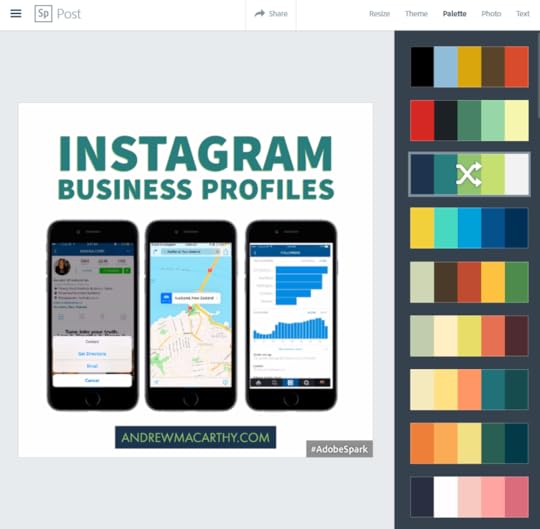
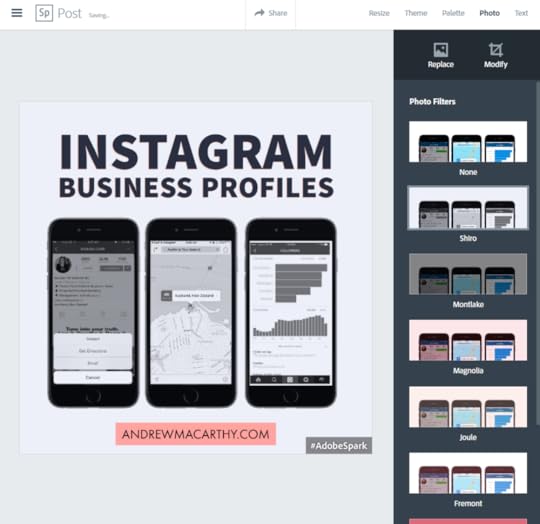
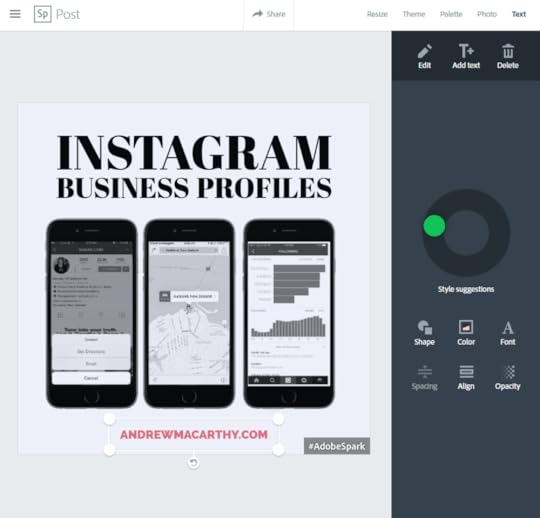
Spark's full customisation options allows you to select the font (around 40 available) and its colour (from a limited palette), align and space text (with preset suggestions, no option to choose exact positions), change the text opacity, and add a variety of shapes to your post. To adjust the size of text, you simply drag the corner of a text box and Spark will adjust the font size to match the position it is dragged to.

One great thing about Spark is its "magic resize" option - the ability to resize a design to automatically fit the recommended proportions for different social networks. This tool is free to use on Spark, but if you want to access it on Canva, you'll need to fork out for its premium offering ($12.95 per month or $119.40 per year).
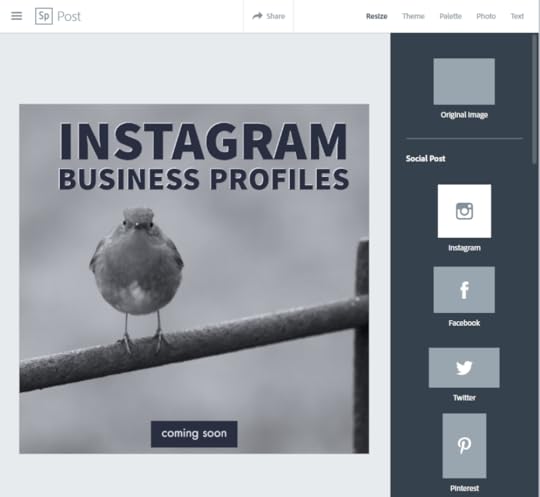
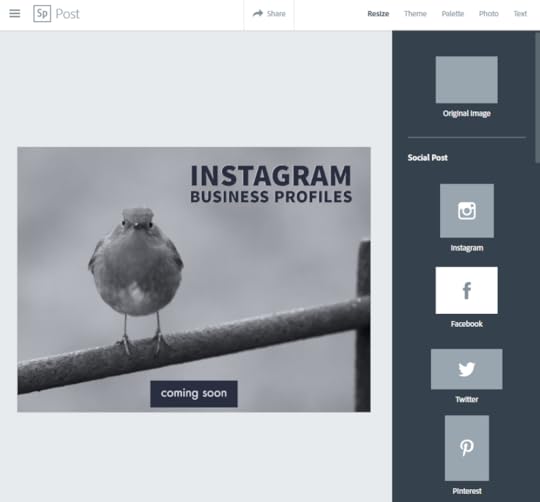
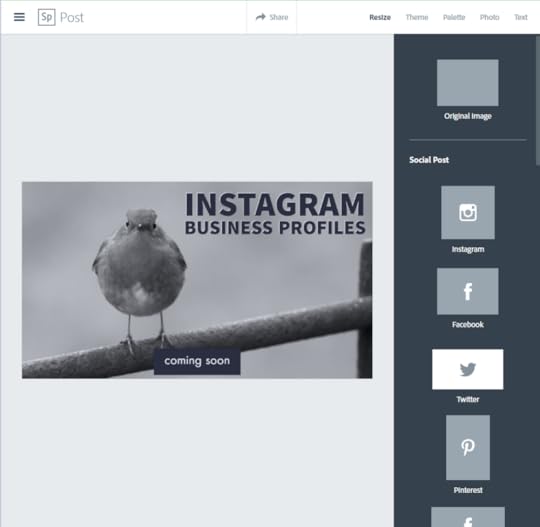
Canva's design and customization options are considerably deeper than Spark's. Rather than themes, Canva offers a selection of editable templates upon the creation of a new project.
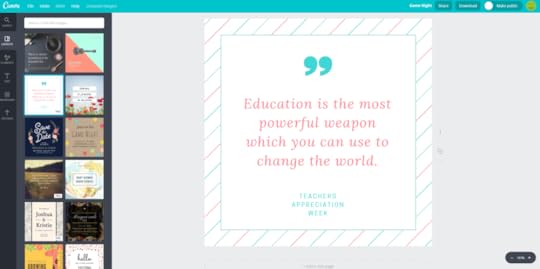
Text can be made bold, italic, uppercase, made into a list, and aligned left, center, and right. Text spacing (individual letters and lines) can be adjusted manually. There are also options to copy text, turn it into a link, adjust its transparency, and move it backwards or forwards in relation to other elements. Canva also offers notably more free fonts, and the ability to choose the exact colour of text using a colour wheel and six-digit hex codes.
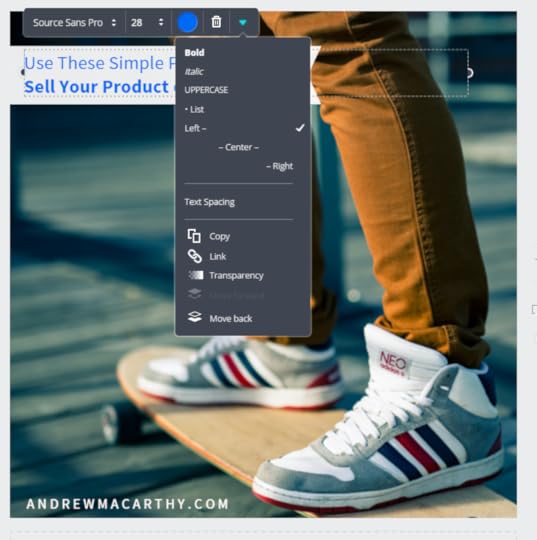
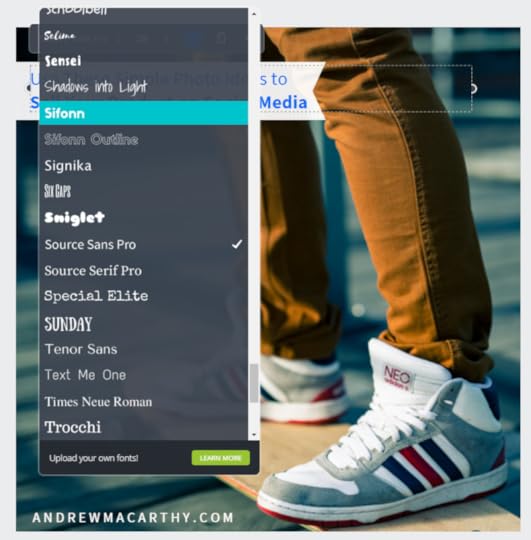

A selection of filters can be applied to images in Canva, and you can also adjust the brightness, saturation, tint, blur, and other factors.
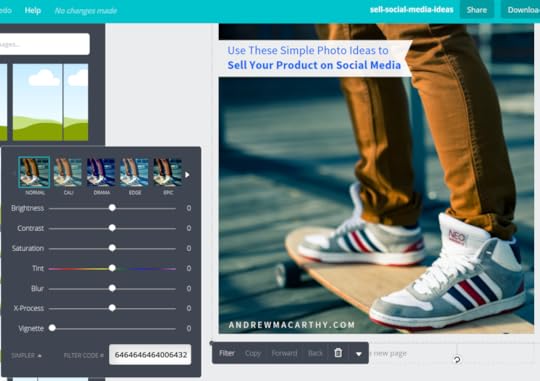
Winner: CanvaLittle niggles and closing thoughts
Both Spark and Canva are incredibly easy tools to use, and both are capable of producing some lovely results. If I were being picky, here are a few little annoyances I have with both platforms:
Spark
No Undo or Redo option.No keyboard shortcuts to speed up process.Restrictive editing and formatting.Cannot upload or re-arrange multple images in single project.Canva
Formatting tools sometimes a bit fiddly to use.Resizing completed images to fit other social networks is hidden by paywall.If I had to choose between the two, then Canva edges it for me and that is the tool I will still be using. Spark does a few things well, but its options are a bit too limited for my liking as things stand. Which image creation tool is your favourite? Let me know in the comments below.

Andrew Macarthy is a social media consultant and the author of the #1 Amazon Web Marketing Bestseller, 500 Social Media Marketing Tips.
Buy 500 Social Media Marketing Tips
Amazon US: http://www.amazon.com/dp/B007L50HE6
Amazon UK: http://www.amazon.co.uk/dp/B007L50HE6
Follow Me:
www.facebook.com/500socialmediatips
www.twitter.com/500socialmediatips
www.instagram.com/500socialmedia
www.pinterest.com/500socialmedia
www.youtube.com/500socialmediatips
May 19, 2016
Use These Simple Photo Ideas to Sell Your Product on Social Media (With Real Examples)

Use These Simple Photo Ideas to Sell Your Product on Social Media (With Real Examples)
Do you want to sell products on social media? Not seeing the reaction you expect?
The primary reason that people visit Facebook and other social networks is to interact with their friends and family; in most cases, they are not browsing with the intention to purchase something. With this in mind, you might find that straight selling with images doesn't work as well for you as it does in other mediums - like a TV ad or in a brochure. You must work smarter and harder to capture their attention.
In this post, I'll show you four simple and creative photo (and video) ideas to help attract the attention of prospects. The examples below are from Clarks Shoes, a British footwear brand, but with a little consideration, all of these ideas can be applied to almost any product. Ready? Let's go!
1. Highlight the detailsIf a customer was interested in your product, either in your physical store or at your website, they'd expect to be able to have a good look at it. The same principle applies to social media. Rather than post a single catalogue-style image of your product, shoot it from multiple angles - back, front, side, far away for perspective, close up to show the detail, etc. Share these images one at a time over several days, or all at once in a gallery.
In the following examples, Clarks shows off its products from multiple perspectives. Note the first example below: as well as highlighting the quality craftsmanship of its product, the ultra close-up works as an interesting and eye-catching photo in its own right. Don't be afraid to experiment, you might surprise yourself with some striking results.
Where video is concerned, the same experimentation applies. You can go simple (a slideshow of several images) or flashier, but potentially more likely to be noticed in the News Feed, with sweeping 360 degree fly-bys.
2. Show your workingsRemember that trend in the early 2000s for computers, phones, and other technology with see-through housing? People are always intrigued and impressed by the "science" inside or behind the products they buy and like to know how much hard work has gone into their design - and this gives you a ready-made piece of content for social media.
In the following example, Clarks uses video to show off the hi-tech material and crafting used to make its footwear.
3. Inspire to make the purchase decision easierInstead of just showing people your product in isolation, show your ideal customer how it will fit into their lives.
In the following examples, Clarks uses images to inspire its customers. One collage shows a man wearing its shoes out on the streets, complete with matching outfit. The other places its shoes next to other items of clothing to show off a potential outfit. Clarks knows that its customers will often think "What will I wear these shoes with?", which might make or break a sale. These types of posts take away any guess work.
As if to highlight the last point even more, Clarks also produces a series of videos in which it shows "3 ways to wear..." its shoes. Each clip shows its footwear teamed with a different outfit. Simple, but effective.
4. Play with shape, symmetry, and colourAt the start of this post, I mentioned that posting a plain catalogue-style image on its own is probably not the best way to garner attention on social media. A large proportion of users have conditioned themselves into a state of ad-blindness (if it looks like anything an advert, they'll just scroll past it), but with a bit of creativity, you can work towards a solution that will grab their attention.
Clarks might "just sell shoes", but it does a really nice job of using what it has to build posts that are clever and aesthetically pleasing . In the examples below, you'll see the use of shape, symmetry and colour to draw in an audience and enhance its message - a combination of elements that we as humans are naturally drawn to. As you view the images, note your own reaction to them and how your customers might react to something similar.
Over to youThese examples from Clarks are a powerful lesson in "making the most of what you have" when it comes to social media marketing. Nothing above is beyond the scope of a small business, and this is coming from a multinational company with the best people and tools at its disposal. Have you been inspired to highlight your products on social media in a different way? Let me know in the comments below!

Andrew Macarthy is a social media consultant and the author of the #1 Amazon Web Marketing Bestseller, 500 Social Media Marketing Tips.
Buy 500 Social Media Marketing Tips
Amazon US: http://www.amazon.com/dp/B007L50HE6
Amazon UK: http://www.amazon.co.uk/dp/B007L50HE6
Follow Me:
www.facebook.com/500socialmediatips
www.twitter.com/500socialmediatips
www.instagram.com/500socialmedia
www.pinterest.com/500socialmedia
www.youtube.com/500socialmediatips
May 9, 2016
5 Awesome Facebook Video Ideas Your Business Should Try (Abel & Cole Case Study)
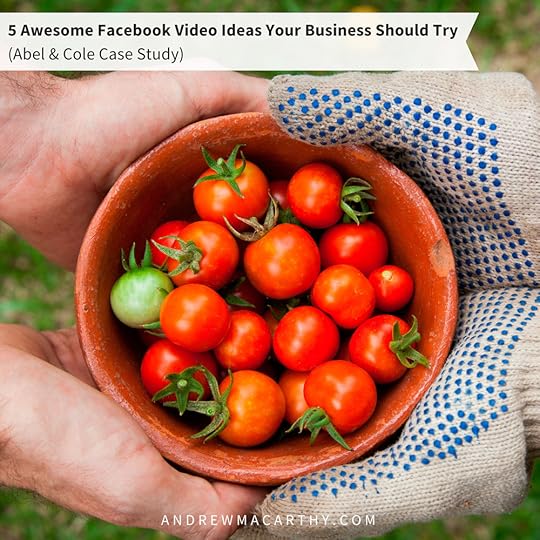
Are you producing video content for Facebook and other social networks? With image posts reaching something of a saturation point, videos are a relatively fresh way to break through the clutter and get your brand noticed.
Here are some recent video statistics, especially related to Facebook:
Facebook now sees 100 million hours of daily video watch time.Facebook generates 8 billion video views every day. Socialbakers’ data revealed that the average organic reach of videos uploaded directly to Facebook was more than twice that of photos - an increase in organic reach of 135%.Abel & Cole is a provider of fresh seasonal organic fruit and veg, meat and household essentials, it does a really nice job of producing high quality, unique, and engaging video content for social media - not as much the ideas, but in the execution. In this blog post, I've picked out five examples of different short videos from Abel & Cole. I hope they will help to inspire you to make your own video content, so let's take a look:
1. Quick Tips (one shot)Here, Abel & Cole shares three ideas for pickling food, all in a single frame. With the composition of ingredients already laid out, only a title "slide" and annotations needed to be added (along with some music) for a quick, quirky and fun way to share information.
2. Guess the amount competitionEveryone's familiar with the "guess how many X in the jar" competitions you see in shops and at fairs, but have you ever thought to host one - through video - on social media? Sticking to it's foody theme, Able & Cole asks fans to comment and guess how many cashew nuts have been dropped into the jar, for a chance to win a snack box. Dropping nuts into a jar like this makes for a much more engaging piece of content than a static image.
3. Creative newsjackingOne of the easiest ways to keep your content fresh is to play on current events, especially if you can put a twist on it to reflect your brand's purpose and personality. In this example, Abel & Cole takes advantage of the annual London Fashion Week to transform fruit and veg into catwalk models, while pushing its message for use of organic produce.
4. Share a funnyHow's this for simple yet effective? It's Christmas, and turkeys make a funny noise. Here's them making it in a large group!
5. Promoting a productIf you're pumping out great content daily and your fans appreciate it what you do, you'll earn the right to publish a promotional piece every now and again. Whether its organic, a paid ad (or a combination of both), putting a little effort into making it something worth watching can make all the difference. As well as tempting shots of its produce, notice how Able & Cole's ad for its veg box can be viewed and understood without sound,
Over to youHave these ideas inspired you to create new videos for Facebook and other social media? Let me know in the comments below.

Andrew Macarthy is a social media consultant and the author of the #1 Amazon Web Marketing Bestseller, 500 Social Media Marketing Tips.
Buy 500 Social Media Marketing Tips
Amazon US: http://www.amazon.com/dp/B007L50HE6
Amazon UK: http://www.amazon.co.uk/dp/B007L50HE6
Follow Me:
www.facebook.com/500socialmediatips
www.twitter.com/500socialmediatips
www.instagram.com/500socialmedia
www.pinterest.com/500socialmedia
www.youtube.com/500socialmediatips
April 29, 2016
Ready For Facebook the Messenger Customer Service Revolution? 6 Steps Every Business Needs To Take Now

Do you use Facebook to handle customer service? The Messenger app is fast becoming the centre of the action for customer interaction on Facebook, and your business needs to be ready.
Facebook Messenger is huge, and growing. At the most recent count in April 2016, it boasted over 900 million monthly active users (up from 700 million just a year earlier), and and over 1 billion messages are now sent between people and businesses each month.
As you probably already are aware, people are increasingly turning to social media to resolve customer service queries and now Facebook wants brands to use it as the cornerstone of their customer service efforts online, making Messenger a one-stop destination for businesses to connect with customers - and it's rolling out the changes thick and fast. If you have messaging enabled for your Facebook Page, fans will get in touch and they expect a response.
In this blog post, I'll show you the 6 big steps you need to get your business ready for customer service via Facebook Messenger.
1. Download and share your Facebook Messenger CodeA Messenger Code is a image (like a QR code or Snapchat's snapcode) that users can scan with their mobile's camera (within the Messenger app) to quickly start a chat with you, saving them having to search for your business manually. You can place it on your website, print it onto your marketing material, or anywhere a customer might want to prompt you with a message. Here's how to get yours:
Visit the Messages section of your Facebook Page and, at the bottom, look for a prompt to download and share your Messenger Code. Click the icon next to it.
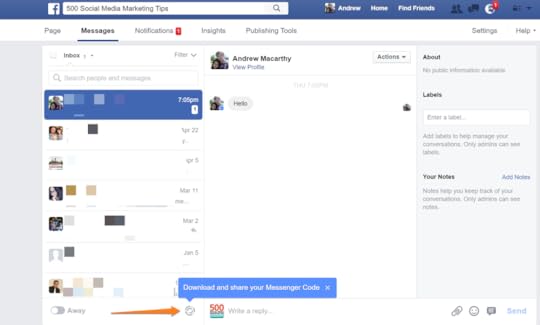
Click the Download button to save your unique Messenger Code in one of three sizes: 300, 600, or 1000 pixels.
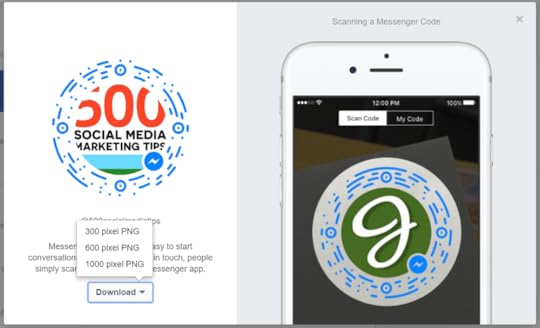
Before you place your code anywhere the public might scan it, test it in the Facebook Messenger app. In the People menu, tap Scan Code. Hover your camera over the code and, if it works correctly, a new Messenger conversation will pop-up instantly.
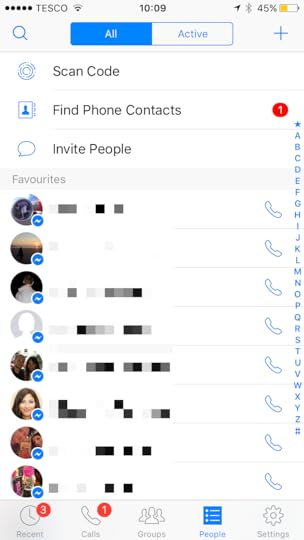
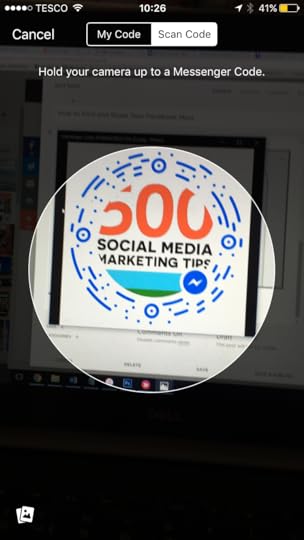

2. Set and share your Facebook Page username
To make it simpler for customers to find and contact businesses, Facebook is making usernames central to a Page's identity. In addition to a business name (your business may have duplicates or similar throughout the world), your unique username can be used to search for your business in Messenger. What's your Page's username? If you already have a vanity URL for your Facebook Page (e.g. facebook.com/500socialmediatips), then the bit after the forward slash becomes your @username, e.g. @500socialmediatips.
3. Manage your Message Response Times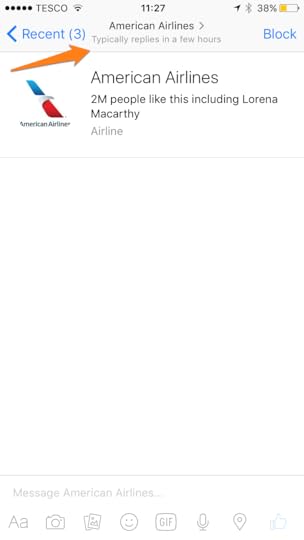
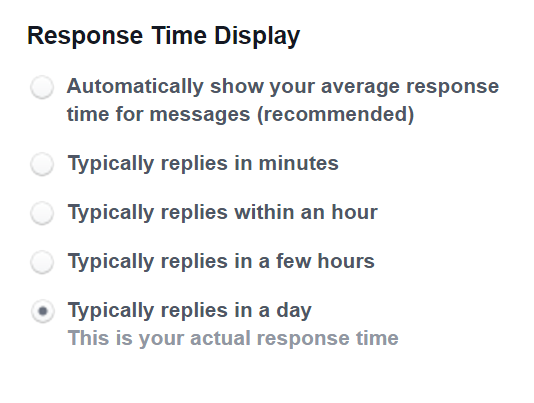
People who send you a message via Messenger or your Page like to know, in advance, how long they can expect to wait for a reply. Obviously the quicker you are, the better. If you visit your Page at least once a week (who doesn't?!) and reply to 90% or more of your messages, your response time will appear in your Page's About section, and at the top of the conversation window in Messenger.
There are several options to help you manage your Response Time. Facebook recommends that you let it display your average response time automatically. Otherwise, you can choose a manual response time (ranging from "typically replies in minutes" to "typically replies in a day." If you choose one of the latter fixed options, you'll really need to be strict about meeting them so not to upset customers.
Set up your Messenger Greeting in the Messaging section of your Page Settings.
4. Write and save your Messenger Greeting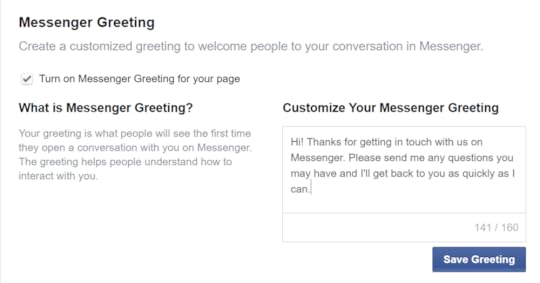
A Messenger Greeting is a short (maximum 160 characters) message that will appear to greet someone the first time they start a conversation with you on Messenger. It's a way of saying hello, letting people know what they can ask. Here's the greeting I have set up:
"Hi! Thanks for getting in touch with me on Messenger. Please send me any questions you may have and I'll get back to you as quickly as I can."
Set up your Messenger Greeting in the Messaging section of your Page Settings.
5. Write and save Instant Replies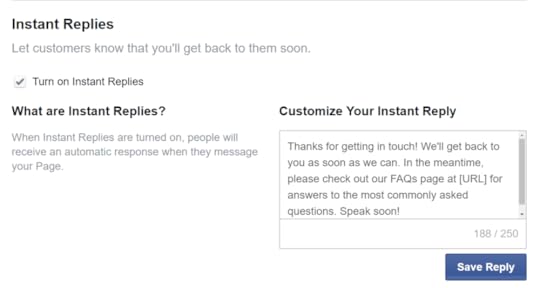
Instant Replies are a way to send an automatic first response when someone messages your Page. There's some overlap here between Instant Replies and the Messenger Greeting, and you don't want an automatic message fired back to come across as cold or impersonal.
Where I can see Instant Replies as being handy is to point customers in the direction of other sources of help (such as website FAQs) while they wait, or as a way to quickly respond to large numbers of customers asking the same question in the event of a customer service crisis.
Set up your Messenger Greeting in the Messaging section of your Page Settings.
6. Write and setup Saved RepliesSaved replies let you create and save a reply for later use, search through older replies to re-purpose it, and the ability to personalise replies instantly with your name, the customer name, your address, website, and more. They're like Instant Replies - perfect for answering common questions quickly - but with added customisation. Here's how to set them up:
Visit the Messages section of your Page and click on the speech bubble icon at the bottom.

Click on Manage Replies to edit your replies, or create a new one.
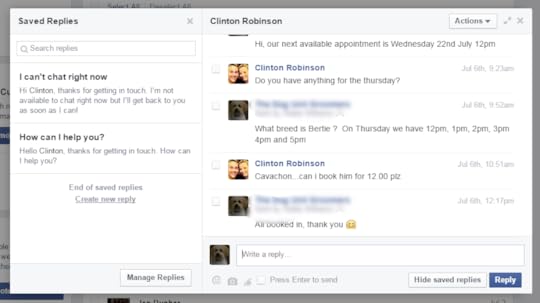

Here, I've mocked up a reply for a fictional company with a "quick reply" for people who ask about its delivery window. It's looking a bit impersonal, though.
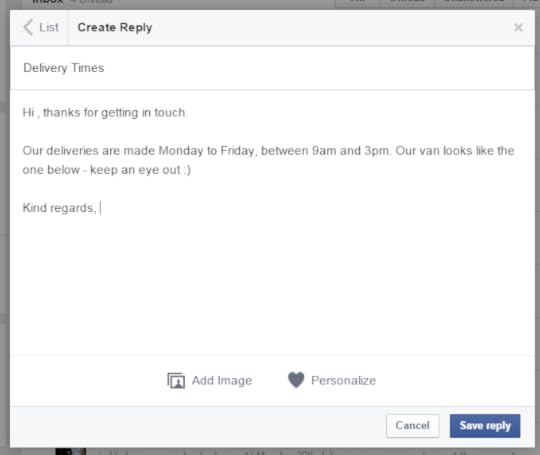
Click "Personalize" for a quick way to add some personal touches to your Saved Replies. Here, you'll be able to add a a variety of automatically-generated "placeholder" elements to your messages. Importantly, you'll want to place your cursor at the part of the message that you want to insert the element, as that's where it will appear when chosen.
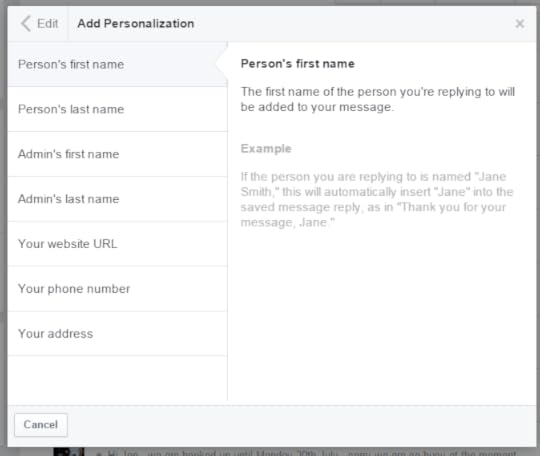
Here's how the personalization looks once it's been added. I've also uploaded an image from my computer. The placeholders will show you the preview of a message - in this case, I've used person's last name (Clinton) and Admin's first name.

Over to you
Will you be using Messenger to handle more of your customer service issues? Do you prefer it over other methods? Let me know in the comments below!

Andrew Macarthy is a social media consultant and the author of the #1 Amazon Web Marketing Bestseller, 500 Social Media Marketing Tips.
Buy 500 Social Media Marketing Tips
Amazon US: http://www.amazon.com/dp/B007L50HE6
Amazon UK: http://www.amazon.co.uk/dp/B007L50HE6
Follow Me:
www.facebook.com/500socialmediatips
www.twitter.com/500socialmediatips
www.instagram.com/500socialmedia
www.pinterest.com/500socialmedia
www.youtube.com/500socialmediatips
April 22, 2016
9 Killer Quotes and Insights for Brands By the Pros At Social Media Marketing World 2016 #SMMW16
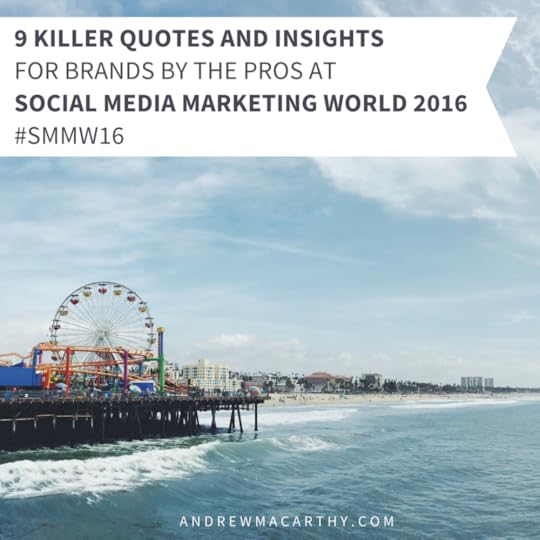
9 Killer Quotes and Insights for Brands By the Pros At Social Media Marketing World 2016 #SMMW16
April 17-19th this year saw Social Media Marketing World 2016 take place in San Diego, California. Organized by Social Media Examiner, it is one of the world's biggest gatherings of social media marketers and experts. If you want the scoop on everything to make the most of social media marketing for business - the cutting edge of what's happening in the industry, you'll find it there.
In this blog post, I've compiled 9 of the juiciest advice and insights from Social Media Marketing World 2016, together with quotes that I encourage you to share! Some of the insights are new, some are reminders of the cornerstones of effective social media marketing, but all are important! Let's get going:
1. Make it easy for people to share your contentHow visible are your blog's share buttons? Do you encourage readers to share? ht @PegFitzpatrick #SMMW16 pic.twitter.com/OXndVPrBAT
— Andrew Macarthy (@andrewmacarthy) April 21, 2016
Readers to your blog are busy people and time poor. They want to share your work if it is valuable, but if you don't make it easy for them, they'll move on without a second's thought. Take some time to re-evaluate the style and positioning of your share buttons. Test them out. Is sharing from your website quick and pain-free?
2. Never stand stillEffective social media marketers never stand still for long #SMMW16 ht @CarlosGil83 pic.twitter.com/lulOinoQ8p
— Andrew Macarthy (@andrewmacarthy) April 21, 2016
Social media marketing strategies change and evolve all the time; stand still and you will quickly get left behind. Be open to accepting new opportunities, and stay ahead of the curve. For example, one of the biggest emerging trends this year is live video.
3. Give more to receiveEarn the right to be trusted and heard, with consistently great, valuable content #SMMW16 ht @ @bryankramer pic.twitter.com/u25UDOc2iC
— Andrew Macarthy (@andrewmacarthy) April 21, 2016
This one's a point I make very often. You have to earn the right to be listened to, trusted, and build a loyal following on social media, you have to give more than you take. In other words, be prepared to offer valuable content that your fans want to see in their news feeds. The type of stuff that makes them want to invest in your brand, without the need for constant promotion.
4 and 5. Be brave and always experimentBe brave, break from your norm to surprise your audience and new loyal fans. #socialmedia #SMMW16 ht @annhandley pic.twitter.com/fHnygtFbFH
— Andrew Macarthy (@andrewmacarthy) April 21, 2016
Keep experimenting to break new ground, never be content with the status quo. #socialmedia #SMMW16 ht @hkovs pic.twitter.com/uHjhI4sQiy
— Andrew Macarthy (@andrewmacarthy) April 21, 2016
These two quotes both hit a similar point, but in an environment where businesses are increasingly struggling to gain traction (especially non-paid), it is imperative that brands don't stand still. If you've tried one strategy and for a while and it isn't working, don't be afraid to change it up and try something new, even if it doesn't work either - better that than stick doggedly to one tired strategy in the hope that your fortunes change. What's more, you need to be offering unique and creative ideas to stand out from the crowd and capture your fans' imagination; to rise above the relentless clutter.
6. Always replyWhen a customer tweets you, they expect a swift response - don't ignore it! #socialmedia #SMMW16 ht @bryankramer pic.twitter.com/dCJRCQrToY
— Andrew Macarthy (@andrewmacarthy) April 21, 2016
One of the biggest UK energy companies, British Gas, announced just this week that it was to close one of its contact centres, with the loss of nearly 700 jobs. The prime reason? More people turning online to get their queries dealt with, including via social media.
Sites like Twitter and Facebook make contact with brands more easy and immediate than ever, and customers expect a response. If you haven't yet put the groundwork down to manage customer service on social media effectively, then now really is the time. Search Twitter for mentions of your brand now. How many customers have you neglected to reply to?
7. The magic of SnapchatThe magic of @Snapchat happens when you make fans part of your story, #socialmedia #SMMW16 ht @Shonduras pic.twitter.com/tyOrXrZ4g0
— Andrew Macarthy (@andrewmacarthy) April 21, 2016
There was big buzz around Snapchat at SMMW16. It's a platform that the majority of brands have yet to exploit, for a variety of reasons: not sure how to use it effectively or if it will work for business, unaware if their audience is there, etc. Snapchat offers a unique opportunity for brands who work to its strengths - it is arguably the best way to humanise your brand while interacting with an audience - and arguably offers a more compelling opportunity to connect with fans than any other social network or app.
8. Embrace live videoEmbrace the unpredictability of live video for social media marketing! #SMMW16 #socialmedia, via @LouMongello pic.twitter.com/O26LmeL3eW
— Andrew Macarthy (@andrewmacarthy) April 21, 2016
As well as Snapchat, live video was touted as one of the biggest emerging trends in social media marketing. The likes of Periscope and Meerkat started it off in earnest last year, but with the global rollout of Facebook Live (and the opportunities that live video brings), the consensus is that all brands should experiment with what it can do for them - one of which, embracing the unpredictability of live video. Sometimes an unscripted chat, with little advanced planning, can make for the most engaging experience.
9. Build a loyal, targeted audienceNot all engagement is equal. Aim for people who'll stick with your brand long term, ht @markwschaefer #SMMW16 pic.twitter.com/vxYP0lwW5e
— Andrew Macarthy (@andrewmacarthy) April 21, 2016
Every business is on the chase for meaningful engagement on social media, but this lesson - to never overlook the quality of your audience in favour of quantity - stood out at SMMW. A small, dedicated audience is always going to be more valuable to you than a large one that doesn't really care about your brand. Focus on building trust and loyalty amongst your fans.
Over to youDid you attend SMMW16? What do you think of the key takeaways listed above? Will you be implementing any of these strategies for your brand? Let me know in the comments below!
April 11, 2016
9 Eye-Catching Photo Ideas For Instagram That Your Business Needs to Try (With Real Examples)
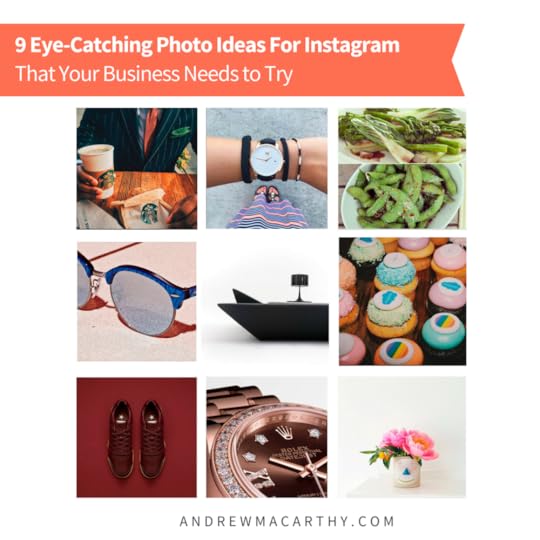
9 Eye-Catching Photo Ideas For Instagram That Your Business Needs to Try (With Real Examples)
Has your Instagram marketing stalled? Looking for fresh new ideas to spark the attention of your audience? Read on.
If there's one social network where one-upmanship rules more than any other, it's Instagram - a hub for creative, eye-catching content creators - brands included. With the recent algorithm change forcing brands to rock their Instagram game more than ever before, here are 9 Captivating Photo Ideas For Instagram That Your Business Should Try.
1. Multiple product shots, multiple angles, one line
When an Instagram user sees your content in their feed, or in search, you'd hope that they'll click through to your full profile to see what else you have to offer. With this in mind, take advantage of Instagram's three-across photo layout to showcase a product in multiple angles.
Rolex consistently uses this approach to showcase its fancy timepieces, as you can see in the example above.
2. Multiple separate posts, one huge image banner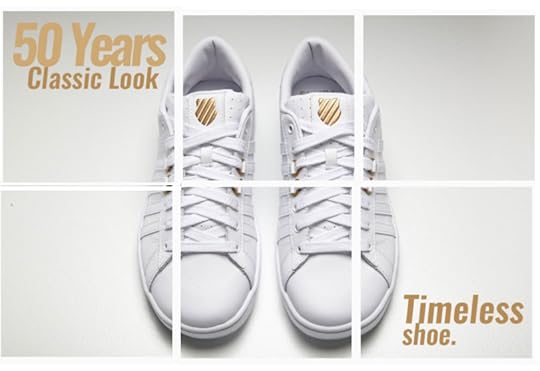
For a twist on the the multiple-posts-for-bigger-impact approach, it is possible to post multiple photos, which don't mean much on their own, but form one large banner ad in your Instagram's profile feed when viewed all together. In the above example, K-Swiss uses this technique to promote one of its products. Each caption of the 6 separate images provides a different piece of trivia about K-Swiss' history.
Of course, you could extend this approach as far as you like. Beware, though, that you could risk spamming your followers with unfathomable content if you go too far with it. 6 is a good target, and I'd say 9 - a nice square, is acceptable, too.
3. Disrupt with white spaceA photo posted by BIRIM (@birimdesign) on Apr 10, 2016 at 6:14am PDT
In my book, 500 Social Media Marketing Tips, I advise against making your Instagram feed look like the pages of a catalogue; full of bland product images and price tags. However, the odd snap that disrupts the norm and catches the eye as a result of its simplicity - like in the example from BIRIM above - I have plenty of time for. Sometimes less is definitely more.
4. Intrigue with ultra close-upsA photo posted by Ray-Ban (@rayban) on Apr 11, 2016 at 7:07am PDT
5. Introduce a mascot
A photo posted by Paintzen (@paintzen) on Apr 11, 2016 at 12:16pm PDT
Just over half-way through, and here's a weird one for you. Mascots can come across as pretty naff and try-hard, but catered to your audience in the right way (subtle is probably best!), they might just become a much-loved and compelling element of your branding. Just look how cute Paint Zen's is...
When you're shooting a product, the most natural idea is to plonk it in the middle of the frame in a nice, staged setting, and snap away. This approach definitely has a place, but when you're catering to a mobile audience, sometimes an ultra close-up - to highlight one particular feature, the material, craftsmanship, etc. can make more of an impact. Why not combine a close-up shot with several other angles to make an across-line collage from tip number one?
6. Split-screen collageMarch 30, 2016
5 New Instagram Features Every Business Needs to Know About (April 2016)

Do you use Instagram for business? Want the scoop on all of the newest updates your business needs to know about?
Since being bought by Facebook, Instagram has evolved at a quicker pace than any time in its history, and the changes continue to come - this time, with at least one real big shift that will impact marketers hugely. Let's take a look at 5 New Instagram Updates Every Business Needs to Know About:
1. Instagram's BIG algorithm change
Some people are really not happy about this. Until now, posts in the feeds of Instagram users by people who they follow had appeared in strict chronological order. Now, however, Instagram will still show all of the posts from people you follow but plans to do so in an order based on how relevant and timely they are to you.
Instagram says that the change is in response to users missing, on average, 70% of posts in their feed - so it wants to make sure you don't mistakenly overlook the content that best resonates with you. For brands, it's a Facebook-ification of the Instagram algorithm, and a clear signal that your content needs to drive engagement, or it may be missed (without paid promotion, at least).
We're listening and we assure you nothing is changing with your feed right now. We promise to let you know when changes roll out broadly.
— Instagram (@instagram) March 28, 2016
Instagram promises that the change isn't going to be immediate, but better to know and be prepared, right?
2. Switching between multiple accounts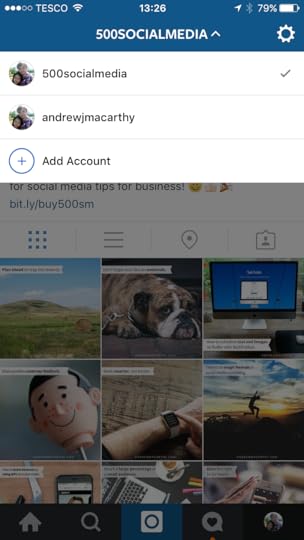
For a feature that users have been desperate to see for years, Instagram sure took its time introducing the ability to switch between multiple accounts. But it's here, and if you manage multiple Instagram profiles, it makes navigating between them - without the annoyance of signing in and out - super easy. Add a new account within settings, then switch by tapping your username at the top of the app's home screen (as in the picture above).
3. Video length limit increased to 60 secondsIn the last six months, the time people spent watching video on Instagram has increased by more than 40 percent. In order to deliver a more rich and engaging experience, the video length limit has been increased from 30 seconds to 60 seconds. Also, video posts now display the number of views they have received - a quick and handy indicator for businesses, and a sign of popularity amongst your audience.
4. The return of multiple clip choice from Library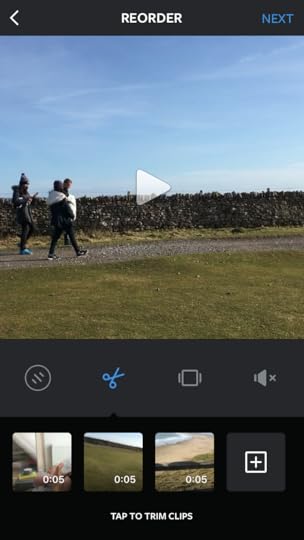
Once a staple of Instagram (and removed for some reason or another), the ability to upload and stitch together multiple video clips from your Library has returned. Choose your first clip, then upload more via the Scissor icon. You can also trim, re-order or delete clips from here.
5. Notifications and Explore for desktop
Take a look at the top of your Instagram account on desktop, and you'll notice two new icons at the top of the page - Explore and Notifications. They're exactly the same as what you'll see in the app, but handy nonetheless.
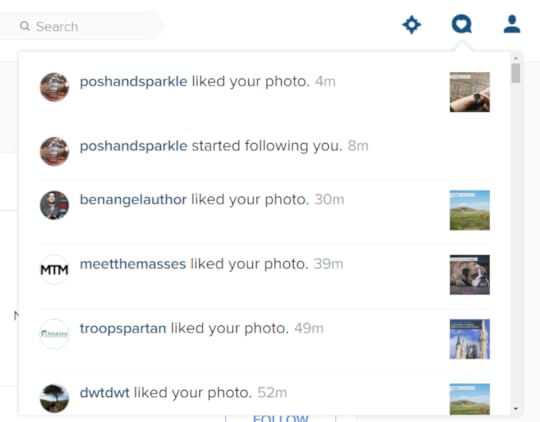
The Notifications tab will alert you to likes and comments on your posts. Clicking one will open the post, where you can add, reply to, or delete comments.
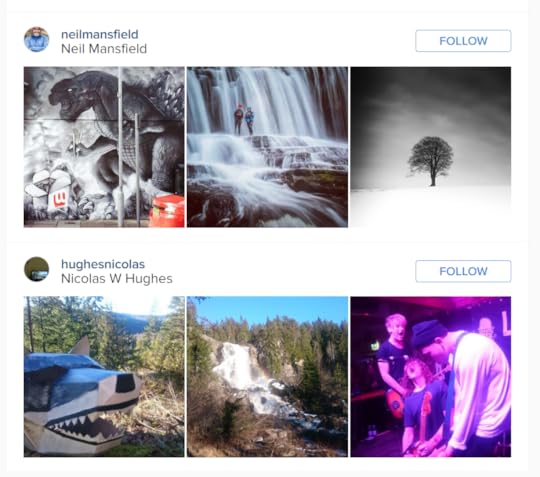
The Explore tab will automatically generate people who Instagram thinks you might be interested in, based on your activity within the app. Use it to find new customers to engage with, reach out to new influencers, and even spy on the competition.
Over to youWhat do you think about the latest changes to Instagram? In particular, do you think the decision to change the algorithm was a good one? Let me know in the comments below!

Andrew Macarthy is a social media consultant and the author of the #1 Amazon Web Marketing Bestseller, 500 Social Media Marketing Tips.
Buy 500 Social Media Marketing Tips
Amazon US: http://www.amazon.com/dp/B007L50HE6
Amazon UK: http://www.amazon.co.uk/dp/B007L50HE6
Follow Me:
www.facebook.com/500socialmediatips
www.twitter.com/500socialmediatips
www.instagram.com/500socialmedia
www.pinterest.com/500socialmedia
www.youtube.com/500socialmediatips
March 20, 2016
How to Bulk Upload And Schedule Posts to Buffer WITH IMAGES Using BulkPublish
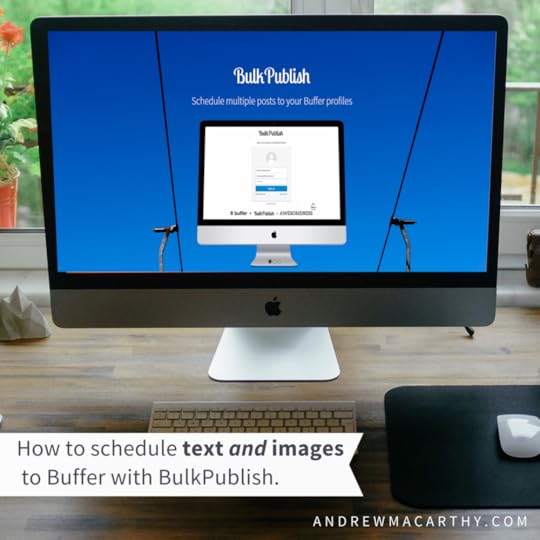
How to Bulk Upload And Schedule Posts to Buffer WITH IMAGES Using BulkPublish
Do you use Buffer to schedule your social media posts? Would you like to bulk upload your content to post text AND images at the same time? In this post, I will show you how.
Using BulkPublish to upload text and images to BufferAt the time of writing, the official Buffer website does not allow you to bulk upload with images (just text), but the third party tool BulkPublish - which sends a prepared file of your content to your official Buffer account - does.
BulkPublish is in beta and quite bare bones, but the process is fairly straightforward. In this blog post I will show you, step-by-step, how to do it. Let's go!
Step 1: Visit BulkPublish.com and sign up for free
Sign up is free. Check your email to confirm your details and sign in.
Step 2: Prepare your content fileBulkPublish requires you to prepare a .csv or .txt file (using Google Docs or Excel), in order to upload and send your scheduled content to Buffer. BulkPublish offers a sample CSV file to download (the link to it is in the image above).
The CSV setup is simple, however. Column A with your content (tweet, Facebook post, etc.), and Column B with the image you want to use. Here's an example of my own file:
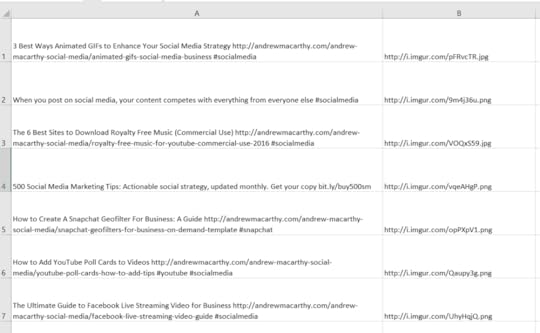
My text column (Column A) has copy that is deliberately short, so that it will upload painlessly to all social networks I chose to share to via Buffer (Twitter, I'm looking at you... restricting the copy to well below 140 characters to accommodate the 20 or so characters used up by an image attached to a tweet, but not including most of the characters used in each link, which is shortened automatically when live on Twitter).

Do note that you will need to add URLs that point directly to where your image is hosted. My host (Squarespace) doesn't make finding this direct link easy, so I uploaded my images to imgur.com, which does. See above, for where I grab the direct URL once I have uploaded an image to imgur.
Step 3: Upload your file and send it to Buffer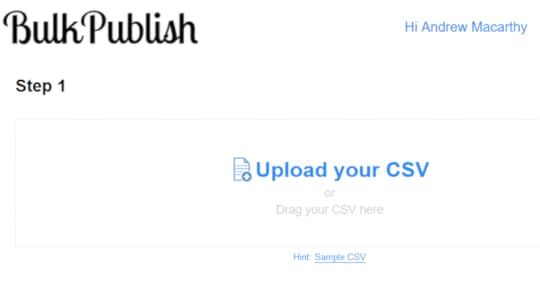
Back at BulkPubilsh, click to upload your CSV or drag the file into your browser. If the .CSV upload fails, try saving your file in a Text (Tab delimited) (*.txt) format instead, then retry.
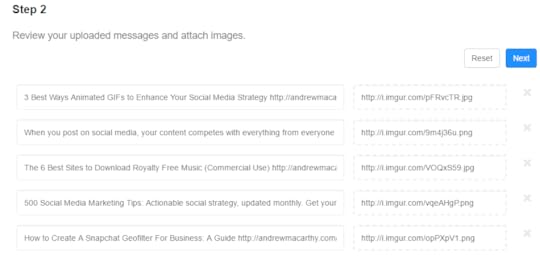
Once your file has been processed, the content will be displayed as above. You can make any final changes here if you like - delete or edit content. Give everything one last check, then hit Next.

Lastly, select the profiles you have connected on Buffer to which you would like the content to be scheduled. When you're done, hit Send to Buffer and the sending process will begin. It will take a little while depending on how much content you have scheduled.
Step 4: Check your Buffer.com account
To ensure everything has gone smoothly, head over to your Buffer.com account and inspect your queues. As you can see from the above screenshot, both the text and images from my content file have loaded and are scheduled according to my Buffer preferences. And that's it, you're done!
Over to youI hope this post has been useful! Will you be using BulkPublish to improve the content you share via Buffer? Do you use any other tools to support your efforts? Let me know in the comments below!



